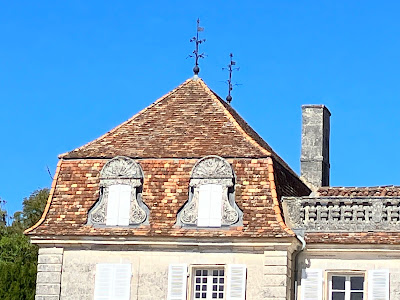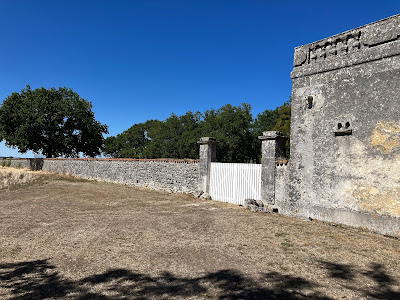There are two private chateaux on the edges of Bourdeilles. I’d heard vague stories that they were once expansive vinyards.There are lingering clues. The fields are rolling, sun drenched, with limestone soils that are well drained. The farmyards have out of scale barns and grand entry ways leading to quiet courtyards. Nowadays the sweeping fields rotate through wheat, corn and sunflowers. There was prosperity here. How this prosperity was lost was a mystery. In my last writing I told you about the agricultural history of the times now I’ll pass on some more familial antidotes.
Going through the catalog of private historical homes to be open during Les Journees de Patrimonies (National open house of historical sights) I noticed that several chateau nearby would be open to the public and were noted for being former vineyards. It was the first time I realized there might be a lot in common with our two local fairytale homes. So we set off in search of a little wine history. We struck gold when we were greeted at each house by owners eager to talk about their family’s history and the rise and fall of regional vineyards. One owner greeted us in his pink trousers and fancy shoes. The other owner met us in his paint splattered cut-off blue jeans shorts and I’m not even sure what shoes.
The first thing to remember is that these are not the old, defensive chateaux of the 16th century One Hyndred Years war. These chateau were constructed at the same time that the young American colonies were questioning their relationship with England.
You will remember from last week’s story that these chateau were built on large farming properties that already existed. Estates that had agricultural wealth, but were living with out-dated conveniences. A famine in the north was driving skilled and unskilled labor to the south of France where they would find work on these prosperous southern farms.
Down went the old farms with small windows, smokey fireplaces, steep pitched Perigordine roofs, muddy courtyards, a pigsty attached to the house, and stinky barns sometimes under the house.
There would be a sense of grandeur in the new homes, but the farmers made one thing clear to the architects and builders— everything had to function as a working farm. Everything on the property would function for livestock, machinery, wine production, housing for workers and ostentatious comfort for the landowner. Once the plans were approved, hungry builders would get to work - and earn the food they so desperately needed. These grand estates were up and humming.
There are big gaps in the history of these chateau. Here are some tidbits passed on in the family lore-
Architectural tidbits:
On the Chateau de la Vassaldie the beautiful balustrade is actually there for functionality - fancy gutters diverting rainwater down to two cistern pools at the entrance to the courtyard. Not a drop of water was wasted in this dry region. Water was imperative for livestock, cleaning, and in particular for washing out the barrels used in wine production. There was a separate well for human consumption. The chateaux themselves had modern conveniences, big light filled rooms, well-drawing fireplaces, sweeping staircases that showed off prosperity and power, and mansard roofs that showed their sophisticated Parisian taste.
Stone walls were built to hide green houses and experiments on vines from the other local vineyards. Everyone was looking for an advantage in the best grape for the best wine.
Household tidbits:
During the tumultuos times of the French Revolution, the wealthy chateuax were subject to the republican rage of the local pesantry. The locals were told to go out and destroy all symbols of Royalty. This included anything that displayed a fleur de lys or a family’s coat of arms. Pigeonniers (Where they kept the pigeons) were targetted as displays of royal-like wealth. The villagers marched out and began their destruction. They managed to pull off and smash the coat of arms that was above the front door. There wasn’t a pigeonnier and the only flour de lys were on the weathervanes* way too high for any local lad. Finally, the owner screwed up the courage to confront the angry mob and offered them a visit to his wine cellar for a drink or two of wine. The locals were a frugal bunch and not used to destroying things so they were easily distracted and gladly accepted the wine and then headed back home. The coat of arms was never replaced because no one has any idea what might have been up there - that blank space is left as evidence of the passing of history.
Several times the house was passed on to the female side of the family. One male owner gambled away the house. It was his sister who said “This is not possible.We are an old family and can’t loose this heritage.” She bought the propriety back from the lawyers and the lineage continued on her side.
In the 1800’s with the wine business booming there was money to modernize the too big, too drafty chateau. Increased wealth allowed for a change in taste and comforts. The already out of date decorative tile was covered up, drafty rooms were covered in dark wood to cozy them up. Fireplaces disappeared behind wooden panels and modern heating was put in.
The current owner’s grandfather died from drinking poisoned well water. He left behind a widow and two children. She did two good things: she raised the children well and she did nothing to the house. When the current owner was born in 1961 there was no water at the house. Water was brought in in 1962.
This reminded him to tell us another story - this house was literally on the road of demarcation between German occupied France and Free France. The Germans commandeered the house - for one day. They were disgusted that the house had no water and no electricity.
Another of the chateau was bought back after it was taken over by the French government during the French Revolution - the Royalist family had to flee to Germany and when they returned they were made to buy back their property. Many years later the current owner’s grandfather was an engineer and had the great idea to add some wings to the house, a little family chapel and English style gardens. New fangled ideas that changed the character of the house.The current owner slowly replacing windows for an authentic look.
In the little chapel one old ancestor was laid out for burial, when her grieving son arrived she sat bolt upright scaring the both of them. She had the family promise that the next time she died they would slice an ankle to see if she twitched and she was not to be buried for eight days. She died at 100, fourteen years after her “first death.”
These grand homes would have been full of laughter, intrigue, heartache and love.
Then disaster struck. The phylloxera blight wiped out all the vines. Pretty much over night everything was lost. There was a scramble to convert to other agriculture. The problem is that the local soil was very good for wine production, but the things that made it good for growing grapes made it a poor source of nutrients in wheat or other crops. The nutritional value of our local wheat is 13% less than other regions. Today’s land prices bear this out: a hectare of land here is about 4000 euros. In Brittany you get 15,000 euros. And a hectare in Belgium goes for 50,000 euros.
All the vinyard machinery was sold off. The barrels, presses, lifts - anything that could be sold in order to pay for new types of equipment. The government offered very little aid to this area. Eventually even the interiors of the houses were sold off. Entire paneled rooms, iron forged stair railings, shutters, garden balustrades, anything that could be pulled off and sold. The idea of selling off your home’s decorations used to make me angry, but now I have better insight into the dire straights these farms found themselves in.
The two chateaux in Bourdeilles were not open to the public. But based on the history of the grapevines their fates would have been similar. There are several other properties in the region that I am just now hearing whispers of. I’ll have to try to visit them on next year’s adventure.
*A bit more on the weather vanes, called pirouettes is French. They are three meters tall and “carved” out of one metal rod peeled like a banana and the details cut into the tips. When the roof was redone ten years ago the roofer exclaimed he’d never seen such fine metal work - a thing of the past.
































2 comments:
Would love to see a photo of the weathervane you described. Interesting story. Thanks.
Fascinating history--well told!
Post a Comment